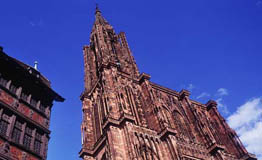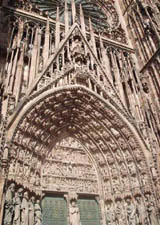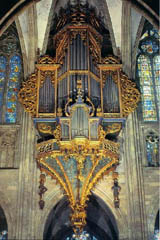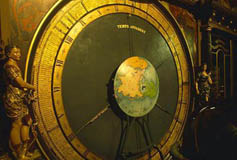Strasbourg Cathedral
Strasbourg Cathedral de Notre-Dame is known as one of the most beautiful gothic cathedrals in Europe. The Cathedral stands on the exact site of a roman temple built on a little hill above the muddy ground. The first version of the church was starting to be built during 1015 by proposal of Bishop Werner von Habsburg, but fire destroyed most of the original Romanesque building. By the time that cathedral was being renovated (at the end of the 12th century, this time with red stones carried from the nearby mountains of Vosges), the gothic architectural style has reached Alsace and the future cathedral was starting to develop all characteristics of gothic aesthetics. The project of the first cathedral in Alsace was handed to craftsman and stonemasons who had already worked on the also famous gothic cathedral in Chartres.
 Although the cathedral was at first financed by the local prince bishop, after his defeat, the municipal bourgeoisie took charge of the work themselves. Also, due to the lack of money, the citizens decided to contribute to the building fund with their private donations. Although the cathedral was at first financed by the local prince bishop, after his defeat, the municipal bourgeoisie took charge of the work themselves. Also, due to the lack of money, the citizens decided to contribute to the building fund with their private donations.
The person who was 1284 selected as an organizer of the whole procedure was Erwin von Steinbach (he himself wanted to donate some money for the building of the church, but as he was penniless, he donated his horse!). He imagined and designed the magnificent west front of the cathedral and its main entrance. By the time of his death, building had progressed – the rose window was being completed and so were his towers. In 1399, Ulrich von Ensingen, the architect of the Cathedral in Ulm, supervised the building of the octagonal base of the spire which was completed after his death by Johannes Hültz from Köln and which soon became the symbol of Strasbourg.
For the next four centuries, due to the height of its tower (142 m), the Strasbourg Cathedral was considered the tallest building in modern world! Furthermore, it was unique because it was one of the few gothic churches equipped with only one tower.
Under the Reformation, in 1521, the cathedral became a Protestant church. After the incorporation of Strasburg into France in 1681, the cathedral was returned to the Catholics and dedicated to the Virgin (the double doorway of the south transept depicts in the tympana two scenes commonly used to honour her death and her coronation in Heaven).
 The cathedral greatly contributes to the history of Gothic sculpture. The façade of the southern cross bar is decorated with the famous Church and Synagogue from the same workshop than produced the remarkable inside pillar of the Angels (1230-1250). While previous façades were certainly drawn prior to construction, Strasbourg has one of the earliest façades whose construction is inconceivable without prior drawing. The statues, dating from the 13th to the 15th century, located above the triple portal of the Gothic façade, depict the Prophets, the Wise and Mad virgins and the Virtues and Vices. The cathedral greatly contributes to the history of Gothic sculpture. The façade of the southern cross bar is decorated with the famous Church and Synagogue from the same workshop than produced the remarkable inside pillar of the Angels (1230-1250). While previous façades were certainly drawn prior to construction, Strasbourg has one of the earliest façades whose construction is inconceivable without prior drawing. The statues, dating from the 13th to the 15th century, located above the triple portal of the Gothic façade, depict the Prophets, the Wise and Mad virgins and the Virtues and Vices.
Inside, it is possible to admire the high Gothic styled baptistery made by Dotzinger (1453), the magnificent pulpit decorated with numerous statuettes sculpted by Hans Hammer in 1485, the Mount of Olives in the northern transept by Nicolas Roeder (1498), and the St. Lawrence's portal dating from the middle Ages.
 The cathedral has many other treasures: stained glass windows dating from the 12th to the 14th century, the St. Pancrace's altar (1522) from Dangolsheim, the 17th-century tapestries forming the Virgin's wall covering purchased in the 18th century, and finally a very popular curiosity, the astronomical clock set up in its own 17th-century case decorated by Tobias Stimmer and using an 19th-century mechanism devised by Schwilgué. To its left, there are 15th-century mural paintings. The cathedral has many other treasures: stained glass windows dating from the 12th to the 14th century, the St. Pancrace's altar (1522) from Dangolsheim, the 17th-century tapestries forming the Virgin's wall covering purchased in the 18th century, and finally a very popular curiosity, the astronomical clock set up in its own 17th-century case decorated by Tobias Stimmer and using an 19th-century mechanism devised by Schwilgué. To its left, there are 15th-century mural paintings.
The presence of an organ is attested as early as year 1260. There was also two other instruments built and modified in 1291 and 1327. The oldest sections of the actual organ case are not older than 1385. The bird's nest was built in the same period. It is built in fir and is hung from the wall by a very large vertical oak beam down to the Samson's statue. To the right, the mobile character depicting a pretzel dealer was the famous Rohraffe (crying monkey) who, with his arm and head, punctuated the insults shouted by a cathedral's servant hidden in the loft during the procession on Pentecost Sunday. The city herald's right arm (on the left) and the lion's mouth are also mobile.
The famous tower was once almost completely destroyed during the French Revolution, inspired by anti-religious believes, some revolutionary leaders ordered its demolition. But, a local locksmith conceived a brilliant scheme of making a huge Phrygian cap made of metal to cover the tower.
The bomb shelling of 1870 and 1944 caused some damage of the Cathedral, but after few renovations and the replacements of missing statues, the Cathedral regained its original look.
The beauty of Strasbourg Cathedral inspired many famous men in history. Here are some of theirs impressions:
Stendhal: "The vault of Strasbourg is one of the most striking monuments I have ever seen".
Goethe: "The more I contemplate the façade of the Cathedral, the more I am convinced of my first impression that its loftiness is linked to its beauty."
Victor Hugo: "The church portals are beautiful, particularly the Roman portal; there are truly superb figures on horseback, the rose-window is noble and well-cut, the entire front of the church is a clever poem. But the true triumph of this Cathedral is the spire. It is a veritable tiara of stone with its crown and its cross. It is a gigantic and delicate marvel.
I have seen Chartres, I have seen Anvers, but I needed to see Strasbourg... From the belfry, the view is wonderful. Strasbourg lays at your feet, the old city of tiled triangular roof tops and gable windows, interrupted by towers and churches as picturesque as those of any city in Flanders. Personally, I would go from one turret to another, admiring one by one, the view of France, Switzerland and Germany via one ray of sunshine."
The Astronomical clock
 Principal work of the Renaissance, this mechanical astronomical clock is an invention put together by various artists, mathematicians and technicians. Swiss watchmakers, sculptors, painters and creators of automatons all worked together to build this amazing automate. The present mechanism dates from 1842 and is especially attractive for the work of its automatons, which, every day at 12.30 pm, all start their show. Principal work of the Renaissance, this mechanical astronomical clock is an invention put together by various artists, mathematicians and technicians. Swiss watchmakers, sculptors, painters and creators of automatons all worked together to build this amazing automate. The present mechanism dates from 1842 and is especially attractive for the work of its automatons, which, every day at 12.30 pm, all start their show.
The first Strasbourg astronomical clock, L'horloge de Trois Rois, was being built from 1352 till 1354, but it stopped working in the beginning of 16th century.
According to a legend, the local authorities of Strasbourg ordered that the constructor of the Astronomic Clock should be blinded so that he could not try to build something like it ever again. This first clock was equipped with various mechanical details that were very rare in that time, such as calendar and astrolabe, as well as very interesting miniature statues. The main statue of the clock was representing Virgin Mary holding baby Jesus in her arms. In front of her, every hour, the three Kings would step out of their chambers and the music announces the time (this automate is now being shown in the Strasbourg museum of Decorative Arts).
At this moment, astronomical clock offers you a view of different stages of life, which are personified by a child, a teenager, an adult and an old man, who pass before Death. Above this are the apostles who walk before Christ. Their passage is punctuated by the beatings of wings and the song of a large rooster. In front of the clock is the marvellous Pillar of Angels, which, in a very original manner, represents the Last Judgment.
Visits every day:
(except 01/01, 01/05 and 25/12)
from April to September, every day from 9am to 7.30pm
from October to March, every day from 10am to 5.30pm
from June to August, until 10pm every Friday and Saturday
Rates
For individuals : 4,40 Euro for adults
2,20 Euro for children (5-18) and students
For groups (+ 20 people) : 3,30 Euro per person
Free entry on the first Sunday of each month.
Apostles animation:
Every day at 12.30pm (south portal from 12.00pm).
Price: 1 Euro
Reduced price: 0, 80 Euro for groups > 12 people, children 6-18.
Free: for children < 6.
Cathedral Platform:
From here, you can enjoy in the magnificent view. On a clear day, you can even see Vosges and Black Forrest from the top of this platform.
November, December, January, February: from 9.00 a.m. to 4.30 p.m.
March, October: from 9.00 a.m. to 5.30 p.m.
April, Mai, June, September: from 9.00 a.m. to 6.30 p.m.
July and August: from 8.30 a.m. to 7.00 p.m.
Entrance: 3.00 Euros
Reduced: 2.30 Euros
Hotels and guided tours
Foto & text Jana Dolecki
|



